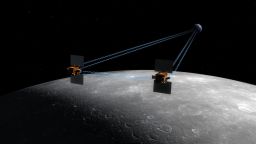Emily Lakdawalla • Jan 04, 2008
GRAIL, the next Discovery mission
As a surprising number of you have written in to remind me, I've neglected to mention a big announcement made last month, that the next Discovery mission, to be launched in 2011, will go to the Moon. The mission is called GRAIL, which is in all caps because it is one of those belabored acronyms that NASA loves, for "Gravity Recovery and Interior Laboratory." Of course it's not proper for the "A" to be in the acronym as "and" isn't capitalized...thus it should be "GRIL" which I think sounds funnier, but it really begs an attempt to restructure the acronym so that the mission could be called "GIRL" instead. Just imagine the headlines: "GIRL Strips Off Moon's Outer Layers..." Sadly, I'll bet the mainstream media would pay much more attention to the mission if it were called GIRL.
Enough silliness. The reason I didn't write about GRAIL right away is because I wanted to get a little more information on exactly what it's going to do. The press release about the mission states that GRAIL will "fly twin spacecraft in tandem orbits around the moon for several months to measure its gravity field in unprecedented detail." Measuring the gravity field is something that has been on lunar scientists' wish lists for a very long time, but it's also one of the primary goals of the Japanese Kaguya mission, which just placed three spacecraft in lunar orbit. How is GRAIL going to be different from Kaguya?
I sent a message to Maria Zuber at MIT, GRAIL's principal investigator, and she explained to me more about how GRAIL is going to measure the lunar gravity field, and that when they're done, their map will be a hundred times more accurate than Kaguya's.
To measure gravity at the Moon, GRAIL has adapted the approach from the very successful GRACE mission that is currently mapping the Earth's gravity field. In essence, GRAIL will place two nearly identical spacecraft in a low-altitude (50 km), near-circular, polar lunar orbit to perform high-precision range-rate measurements using a Ka-band ranging system. The ranging system consists of an antenna assembly for transmission and reception of range tones, a microwave assembly that generates the Ka-band signals, a processing unit for phase measurements used to measure range, and a time transfer assembly to coordinate data sampled between the two satellites. A radio beacon will be used to calibrate timing on the spacecraft by the NASA Deep Space Network. Analysis of the spacecraft-to-spacecraft range-rate data provides a direct measure of the lunar gravity field.If Kaguya performs in a manner consistent with the most optimistic expectations, GRAIL data will be two orders of magnitude more accurate and the observations will have a factor of two better spatial resolution.
Support our core enterprises
Your support powers our mission to explore worlds, find life, and defend Earth. You make all the difference when you make a gift. Give today!
Donate

 Explore Worlds
Explore Worlds Find Life
Find Life Defend Earth
Defend Earth


